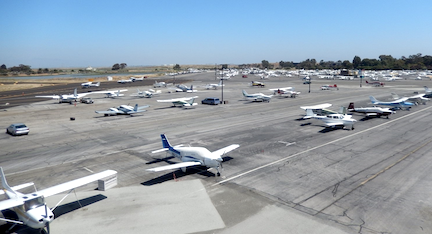
By Braden Cartwright
Daily Post Staff Writer
The Federal Aviation Administration won’t allow Palo Alto City Council to crack down on lead fuel and noise pollution at the Palo Alto Airport, Airport Manager Andrew Swanson said.
That’s because the city has accepted grants from the FAA that commit the airport to the FAA’s guidelines for 20 years, Swanson told council on Monday (March 6).
The city can’t stop selling lead fuel or even charge more for it, Public Works Director Brad Eggleston said.
Santa Clara County banned the sale of lead fuel at Reid-Hillview Airport in San Jose after a study found that children living within a half-mile of the airport had increased levels of lead in their blood, which could impact their development.
The FAA started investigating the county for violating its grant requirements, but the investigation is on hold for six months as the airport participates in a nationwide study on transitioning to unleaded fuel.
“Frankly, the FAA was, at best, remiss for decades and at worst, really committing a serious environmental failure by not eliminating lead from prop engines like they could,” Councilman Pat Burt said Monday, accusing the agency of folding to industry pressures.
The Palo Alto Airport will have a tank with unleaded fuel available in June if the equipment arrives on time in May, Swanson said.
But planes can’t be required to use it, and some don’t have the engines to do so, he said.
Instead, the airport will try to convince pilots to make the switch, Swanson said.
Councilwoman Vicki Veenker suggested giving better hangar space to planes that use unleaded fuel.
Mayor Lydia Kou said she wanted noise and lead monitors installed and to revisit the flight paths so they aren’t as noisy to residents.
Burt said that planes are taking off in the middle of the night, and residents of East Palo Alto are complaining. They will insist on closing the airport if their concerns aren’t addressed, he said.
East Palo Alto Councilman Ruben Abrica said during last year’s campaign that he wanted to explore phasing out the airport.
“If we don’t step up, the whole airport will be in jeopardy, Burt said.
Swanson told council that some of the planes taking off at night may be related to law enforcement, but he didn’t have numbers on how many night flights occur.
The airport doesn’t know who is taking off until after the fact, and night flights also can’t be prohibited because of the FAA’s grant requirements, Swanson said.
Councilwoman Julie Lythcott-Haims tied the airport discussion back to council’s Feb. 27 vote banning e-bikes on unpaved trails in the Baylands, partly because of the noise. She voted against the ban because she said e-bikes allow people who are out of shape to have fun and get outside.
It’s hard to imagine all of the e-bikes together would be louder than one plane, she said.
Council members cheered on the airport’s efforts to be a state-of-the-art facility for electric planes, and they encouraged the airport to have solar panels.
The airport’s “apron,” where planes are parked, refueled, maintained, loaded and unloaded, is almost done being reconstructed with capacity for electric planes, with funding from the FAA.
The city of Palo Alto took over the airport from Santa Clara County in 2014 and has turned it into a money-making enterprise. The airport has $2.1 million in yearly costs and $2.7 million in revenues, leaving $600,000 for improvements, Eggleston said.
The general aviation field on Embarcadero Road is home to 360 aircraft and five flight schools.
The city is beginning a long-range facilities and sustainability plan for the airport over the next year to 18 months. The public will be invited to weigh in starting this spring.
